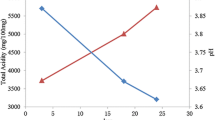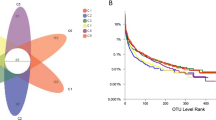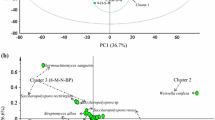Abstract
Denaturing gradient gel electrophoresis (DGGE) was applied to investigate the bacterial community in traditional Meigui rice vinegar produced in Zhejiang province, China. The V3 regions of 16S rDNA were amplified with universal primers (GC-338F and 518R). Nine dominant DGGE bands were isolated, cloned, and sequenced. They were most similar to Acetobacter pasteurianus, A. aceti, Lactobacillus delbrueckii subsp bulgaricus, Gluconobacter oxydans, Leuconostoc mesenteroides subsp mesenteroides, Lb. reuteri, Lb. casei, and Lb. acidophilus. Of which, A. pasteurianus and Lb. delbrueckii subsp bulgaricus are two dominant species, and occur along the whole acetic acid fermentation process. Lb. bulgaricus, G. oxydans, and A. pasteurianus dominated in the last phase of the fermentation. G. oxydans is first identified in the Meigui rice vinegar broth, and occurs in the last phase. The DGGE profile also indicated that bacterial community transition took place at the initial stage at which acetic acid fermentation stage started.
Access provided by Autonomous University of Puebla. Download conference paper PDF
Similar content being viewed by others
Keywords
1 Introduction
Wine vinegar is primarily produced with an enological tradition in European countries (e.g., balsmic vinegar in Italy, and sherry vinegar in Spain) [1]. In Northeastern regions of Asia, such as Japan and China, vinegar has been traditionally produced from cereals, primarily rice [2]. Vinegar fermentation from cereals requires a saccharification step in addition to the alcohol fermentation and oxidation of ethanol to acetic acid. In China, the saccharification of rice is conducted by moulds such as Aspergillus oryzae. Alcohol fermentation with yeast is performed either after saccharification process or at the meanwhile as saccharification. The alcoholic medium is used for acetic acid fermentation. For acetate production there are two well-defined methods, traditional static surface fermentation and modern submerged fermentation [3].
“Meigui rice vinegar”, one famous traditional rice vinegar in China, has been manufactured since the 1900s at Zhejiang Province. This type of rice vinegar is produced in a ceramic jar (1,000 L volume) with rosy color, sort sweet, soft and sterling aroma, and particular flavor, referred as “Meigui rice vinegar”. The brewing process is completely unique, the whole process (i.e., saccharification, alcohol fermentation, and acetic acid fermentation) proceeds within the same jar, and without any controls such as the temperature, aeration, and pure culture inoculation. The materials are used: steamed rice, water, and natural microbial community from the environment; no additional microorganisms are inoculated during the fermentation process. Jar fermentation begins often at the spring only, continues to winter or next spring. The diversity and succession of microorganisms involved in jar vinegar fermentation are of considerable interest, since there are three microbiological precesses simultaneously or sequentially in a single jar; furthermore, no pure microorganisms are used for inoculation. Microbiological studies of vinegar fermentation have been reported by convertional cultivation approaches. Recently, culture-independent techniques such as 16S rRNA genes, have suggested the existence of a vast undiscovered microbial diversity, and been applied to analyze food ecosystems. In the case of vinegar bacteria, it has been reported that conventional plate counts were considerably lower than the fluorescence optical counts of microbial cells from industrial acetatoers.
DGGE is a well documented culture-independent method for analysis of microbial communities in environmental and food samples [4]. Compared to traditional culturing, these methods, generally based on nucleic acids such as the 16S rRNA gene, aim at obtaining both a qualitative and a semi-quantitative picture of a microbial community without the need to isolate and culture its single components [5]. However, it has previously been demonstrated that while these techniques are valuable, there is a need to use a combined system to overcome the bias of the “culture-(in)-dependent-only” approach [6, 7]. Therefore, culture-independent and cultivation methods should be applied in parallel for population dynamics and biodiversity studies. Recently, such an approach was applied to study the bacterial community traditional fermentation food [8–13].
In this paper, we applied the denaturing gradient gel electrophoresis (DGGE) method technique to analyze the dynamic of bacterial communities in Zhejiang Meigui rice vinegar during the fermentation process.
2 Materials and Methods
2.1 Vinegar Samples
Twenty samples from Hangzhou Niangzhao Shipin Factory were collected. The vinegar samples were centrifuged at 4 °C, 9,000 r/min for 5 min, and then the bacterial cells in the suspension was harvested by centrifugation at 4 °C, 12,000 r/min for 5 min the precipitate was stored at −70 °C.
2.2 Bacterial DNA Extraction
The genomic DNA of each strain was extracted using a modification of the cetyltrimethylammonium bromide method [14]. In brief, the cells were washed with sterile distilled water. Then the pellets were suspended in saline EDTA buffer (0.15 M NaCl and 1 M EDTA, pH 8.0). The cell lysis was induced by addition of 10 mg ml−1 lysozyme solution. After addition of 10 mg ml−1RNAse, the tube was incubated at 37 °C for 30 min. Proteinase K (20 mg ml−1) was added and the incubation was done at 37 °C for 60 min. Afterwards, 40 μl of 25 % sodiumdodecyl sulfate (SDS) solution was added and incubated at 65 °C for 10 min, then 180 μl of a 5 M sodium acetate solution was assed and the cell polysaccharides were eliminated by the addition of 100 μl of 2 % cetyltrimethylammonium bromide (CTAB) solution and centrifuged at 10,000 × g for 10 min. Chromosomal DNA was further twice purified by extraction with chloroform/isoamylic alcohol (25:1, v/v), precipitated by transferring the upper aqueous phases to new tubes and adding twice cold absolute ethanol. The chromosomal DNA was resuspended in 100 μl of highly purified H2O. The size of the DNA was checked by 1 % agarose gel electrophoresis in 1X TAE buffer (40 mM tris base, 20 mM acetic aced glacial, 1 mM EDTA 0.5 M, pH 8.0) with a 23 Kb DNA ladder (TaKaRa, China) as size marker. The gel was visualized by ethidium bromide staining under UV light.
2.3 PCR Amplification of the V3 Region of 16S rDNA
The V3 region of 16S rRNA gene was amplified for bacterial community analysis. The primers used to amplify the V3 region were as follows: 338f (5′-ACTCCTACGGGAGGCAGCAG-3′) and 518r (5′-ATTACCGCGGCTGCTGG-3′) [15] GC-clamp (5′-CGCCGCCGCGCGC GGCGGGCGGGGCGGGGGCACGGGGGG-3′) were attached to the 5′ end of primer 338f [16]. Amplification was performed in a final volume of 50 ml containing 1 × PCR buffer, 1.5 mM MgCl2, 0.2 mM dNTPs, 2.5 UI Taq- polymerase (TaKaRa, China), 0.2 mM each primer, and the template DNA. In order to increase the specificity of amplification, a touchdown PCR was performed using an annealing temperature of 10 °C above the expected annealing temperature of 55 °C [17]. The temperature from 65 °C was decreased by 1 °C each second cycle until the touchdown temperature of 55 °C was reached. Ten additional cycles were carried out at 55 °C. A denaturizing step of 95 °C for 1 min was used and extension was performed at 72 °C for 3 min with a final extension of 10 min at 72 °C which finished the amplification cycle. The PCR products (5 ml) were analyzed by electrophoresis in agarose gel [18].
2.4 DGGE Analysis
DGGE analysis was carried out on the DcodeTM Universal Mutation Detection System (Bio-Rad, USA). Electrophoresis was performed with 1 mm-thick 6 % polyacrylamide gels (acrylamide-bisacrylamide, 37.5:1) submerged in 1 × TAE buffer (40 mM Tris, 40 mM acetic acid, 1 mM EDTA; pH 8.0) at 60 °C. Approximately, 600–800 ng of PCR product from environmental samples and 100 ng of PCR product from cultures were applied to individual lanes in the gel [17]. The following electrophoresis conditions were selected based on the results of perpendicular DGGE and time travel experiments. The perpendicular electrophoresis was performed at 80 V for 1 h in a linear 0–100 % denaturant agent gradient (100 % denaturant agent was defined as 7 M urea and 40 % deionized formamide). After electrophoresis, the gels were stained in 1 × TAE solution containing ethidium bromide (50 μg/ml) for 10 min and photographed under UV transillumination and analyzed by Quantity One software (Bio-Rad).
2.5 Sequencing of 16S rDNA Regions
Selected DGGE bands were excised from the denaturing gels, eluted in 30 μl of sterile water, and incubated over night. And 5 μl of diffused DNA supernatant was used as template for reamplification with primers F338-GC and R518. The e-amplified PCR products were examined by DGGE to confirm that single bands were present at the same positions. Sequencing was carried out by TaKaRa using ABI PRISM™ 377XL DNA Sequencer. To determine the closest known relatives of the partial 16S rDNA sequences obtained, searches were performed in public data libraries with the BLAST.
3 Results and Discussion
3.1 Mega DNA Extraction and PCR Process of V3 of 16S rDNA
In the same genomic DNA samples for template, primers like F338-GC/R518 with not GC splint primer and GC splint were used. All use touchdown PCR reaction procedure. The length of PCR products is about 230 bp. Parallel DGGE profiles of PCR products of 16S rDNA with different primers (Fig. 43.1). The DGGE profiles of different PCR products were performed and supported a good seperation when F338-GC/R518 used as the primers (Fig. 43.1b).
3.2 DGGE Optimization
The denaturing range and time of electrophoresis were optimized in our study (Fig. 43.2). Between a gradient of denaturant concentrations of 35–55 %, the DNA fragments displayed reduced mobility(Fig. 43.2a). Moreover, the fragments of different sequences were separated absolutely. After that time travel experiments with the mixture of PCR products were conducted to determine the optimal electrophoresis time. PCR products were loaded into a gel every 0.5 h and electrophoresis at 150 V (Fig. 43.2b). Bands were defined most clearly and showed reduced mobility for 4.0 h. Thus, the electrophoresis conditions were obtained at 150 V, 60 °C for 4 h.
3.3 DGGE Profile of the Bacterial Community of Meigui Vinegar Fermentation Process
The transition of the bacterial community throughout the fermentation process is shown in Fig. 43.3. In the DGGE profiles, the brighter bands represent the dominant bacteria [19]. DNA sequences of eight representative bands were determined and blasted in Genbank (Table 43.1), whereas the other bands were not determined due to the failure, to reproducibly amplify the excised bands. Comparison of V3 regions of 16S ribosomal DNA sequences similarity revealed that the dominating microbial species were Acetobacter pasteurian, Lactobacillus delbrueckii subsp bulgaricus, Gluconobacter oxydans, Leuconostoc mesenteroides subsp mesenteroides, Lactobacillus reuteri, Lactobacillus casei, Lactobacillus acidophilus NCFM.
The DGGE profile indicated that there are dramatic difference about bacterial community between “Fahua” phase and fermentation phase. The “Fahua” phase was characterized by bands related to Leu. mesenteroides, Lb. reuteri, Lb. casei, Lb. casei, and A. pasteurianus. Lb. reuteri (band 2) was detectable from day 13 to day 49. A. pasteurianus and Lb. bulgaricus occurred along the whole fermentation process, while G. oxydans was first identified in the rose vinegar, just occurred in the last phase. Only Lb. bulgaricus, G. oxydans, and A. pasteurianus dominated in the last phase of the fermentation.
4 Conclusion
In this study, PCR-DGGE analysis demonstrated the clear succession of microbial communities during the fermentation process of Zhejiang Meigui rosy rice vinegar. The DGGE profile indicated dynamic changes in the bacterial population at the transition from saccharification phase to alcohol fermentation, and acetic acid fermentation phase. Moreover, the bacterial population during the fermentation process were distinct from that observed in the starting materials. The similar change of microbial community also happened in the Japanese rice vinegar [2]. However, the bacteria which was determined by DGGE was different in these two case, there are five bacteria determined in the Japanese rice vinegar, i.e., Lb. fermentum, Lactococcus lactis, Pediococcus acidilactici, Lb. acetotolerans, and A. pasteurianus. In the Meigui rice vinegar DGGE process showed that the following species would be dominants, A. pasteurianus, A. aetic, Lb. delbrueckii subsp. bulgaricus, G. oxydans, Leu. mesenteroides subsp mesenteroides, Lb. reuteri, Lb. casei, and Lb. acidophilus. Of which, A. pasteurianus and Lb. delbrueckii subsp bulgaricus are two dominant species, and occurred along the whole acetic acid fermentation process. Lb.bulgaricus, G.oxydans, and A.pasteurianus dominated in the last phase of the fermentation. G. oxydans is first identified in the Meigui rice vinegar broth, and occurred in the last phase too. The DGGE profile also indicated that bacterial community transition took place at the the initial stage when acetic acid fermentation stage started.
References
Gullo M, Giudici P (2008) Acetic acid bacteria in traditional balsamic vinegar: phenotypic traits relevant for starter cultures selection. Int J Food Microbiol 125:46–53
Haruta S, Ueno S, Egawa I et al (2006) Succession of bacterial and fungal communities during a traditional pot fermentation of rice vinegar assessed by PCR-mediated denaturing gradient gel electrophoresis. Int J Food Microbiol 109:79–87
Tesfaye W, Morales ML, Garcia-Parrilla MC et al (2002) Wine vinegar: technology, authenticity and quality evaluation. Trends Food Sci Technol 13:12–21
Kusar D, Avgustin G (2012) Optimization of the DGGE band identification method. Folia Microbiol 57:301–306
Nakatsu CH, Torvik V, Ovreas L (2000) Soil community analysis using DGGE of 16S rDNA polymerase chain reaction products. Soil Sci Soc Am J 64:1382–1388
Ritz K, Wheatley RE, Griffiths BS (2007) Effects of animal manure application and crop plants upon size and activity of soil microbial biomass under organically grown spring barley. Biol Fert Soils 24:372–377
Oger JC, El-Baradei G, Delacroix-Buchit A (2008) Bacterial biodiversity of traditional Zabady fermented milk. Int J Food Microbiol 121:295–301
Wu JJ, Ma YK, Zhang FF et al (2012) Biodiversity of yeasts, lactic acid bacteria and acetic acid bacteria in the fermentation of “Shanxi aged vinegar”, a traditional Chinese vinegar. Food Microbiol 30:289–297
Lv XC, Weng X, Zhang W et al (2012) Microbial diversity of traditional fermentation starters for Hong Qu glutinous rice wine as determined by PCR-mediated DGGE. Food Control 28:426–434
Tanaka Y, Watanabe J, Mogi Y (2012) Monitoring of the microbial communities involved in the soy sauce manufacturing process by PCR-denaturing gradient gel electrophoresis. Food Microbiol 31:100–106
Liang ZB, Drijber RA (2008) A DGGE-cloning method to characterize arbuscular mycorrhizal community structure in soil. Soil Bio Biochem 40:956–966
Bouity MD, Frigon JC (2008) Comparison of treatment efficacy and stability of microbial populations between raw and anaerobically treated liquid pig manure, using PCR-DGGE and 16S sequencing. Can J Microbiol 54:83–90
He F, Huang D, Liu L (2008) A novel PCR-DGGE-based method for identifying plankton 16S rDNA for the diagnosis of drowning. Forensic Sci Int 176:152–156
Knapp JE, Chandlee JM (1996) RNA/DNA mini-prep from a single sample of orchid tissue. Biotechniques 21:54–56
Tae WK, Jun HL, Sung EK et al (2009) Analysis of microbial communities in doenjang, a Korean fermented soybean paste, using nested PCR-denaturing gradient gel electrophoresis. Int J Food Microbiol 131:265–271
Fushuku S, Fukuda K (2008) Inhomogeneity of fecal flora in separately reared laboratory mice, as detected by denaturing gradient gel electrophoresis (DGGE). Exp Anim 57:95–99
Cherif H, Ouzari H, Marzorati M et al (2008) Bacterial community diversity assessment in municipal solid waste compost amended soil using DGGE and ARISA fingerprinting methods. World J Microb Biotechnol 24:1159–1167
Yoshida A, Seo Y, Suzuki S et al (2008) Actinomycetal community structures in seawater and freshwater examined by DGGE analysis of 16S rRNA gene fragments. Mar Biotechnol 10:554–563
Zidkova K, Kebrdlova V (2007) Detection of variability in apo(a) gene transcription regulatory sequences using the DGGE method. Clin Chim Acta 376:77–81
Acknowledgments
The work was financially supported by National Nature and Science foundation of China (3117175), Nature and Science foundation of Zhejiang Province (Y3100609), and Open Funding of Key Fermentation Engineering Lab of Hubei Industry University (2010Y053).
Author information
Authors and Affiliations
Corresponding author
Editor information
Editors and Affiliations
Rights and permissions
Copyright information
© 2014 Springer-Verlag Berlin Heidelberg
About this paper
Cite this paper
Shi, J., Liu, Y., Feng, W., Chen, X., Zhu, Y., Liang, X. (2014). Investigation of Bacterial Diversity in Traditional Meigui Rice Vinegar by PCR-DGGE Method. In: Zhang, TC., Ouyang, P., Kaplan, S., Skarnes, B. (eds) Proceedings of the 2012 International Conference on Applied Biotechnology (ICAB 2012). Lecture Notes in Electrical Engineering, vol 249. Springer, Berlin, Heidelberg. https://doi.org/10.1007/978-3-642-37916-1_43
Download citation
DOI: https://doi.org/10.1007/978-3-642-37916-1_43
Published:
Publisher Name: Springer, Berlin, Heidelberg
Print ISBN: 978-3-642-37915-4
Online ISBN: 978-3-642-37916-1
eBook Packages: EngineeringEngineering (R0)







